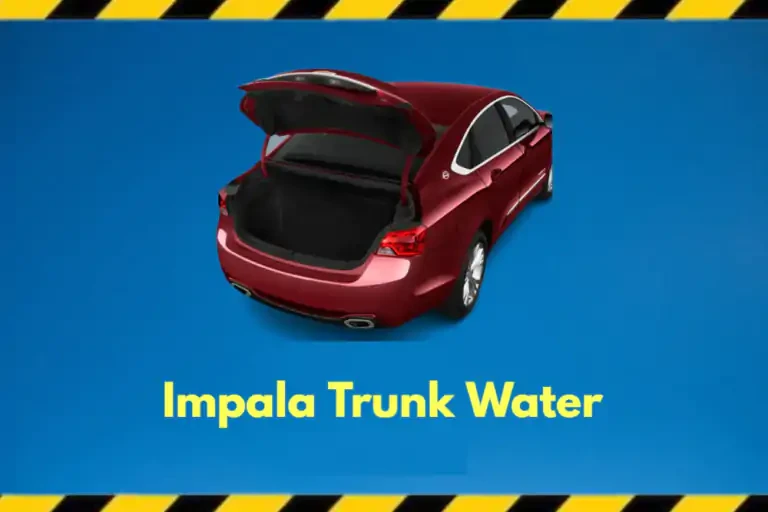Hello to all of you! I believe you’re doing fantastic. If you are our daily visitor, you can take here a familiar environment and get a nice surprise! Here, we offer fresh ideas and insights about cars and trucks tailored just for you.
You can learn about the issue of the Impala water trunk. Water gathering in the trunk of 2014-2024 Impala vehicles is a common issue. In this article, you can understand the reasons for taking the proper steps to solve critical problems for sustaining the vehicle’s integrity and functionality.
Also, check Which Chevy Engine Style Is Better? Small Block Vs. Big Block
Water In The Trunk of 2014 – 2024 Impala
- The trunk of a Chevy Impala is sometimes overlooked at first.
- It usually builds up in the spare tire wheel well, a mostly used region.
- This can cause rust on many pieces of equipment and a musty odor in the cabin.
- A damaged rubber seal helps water to enter the taillight.
- Over time, the seal shrinks or wears down, reducing its sealing effectiveness.
- The seal may fail in some situations, enabling condensation to enter and collect in the trunk bed.
- To resolve this issue, you must replace the taillight gasket seal.
- The procedure is straightforward and can be completed at home.
Explaining: Why Water Accumulates In The Trunk?
Many things can involve water collection in the trunk of 2014-2024 Impala models. Understanding these factors is important for dealing with the problem normally. Some important reasons are as follows:
Faulty Trunk Seal: A faulty trunk seal might allow water to enter the trunk compartment.
Worn Weatherstripping: Weatherstripping around the trunk lid may deteriorate with time, enabling water to enter.
Blocked Drainage Channels: Debris or foreign items might clog drainage channels, preventing water from draining away from the trunk.
Other Water Sources In The Impala Trunk
There are many possible sources of water leakage into the trunk of 2014-2023 Impala vehicles. These are some examples:
Faulty Trunk Seal: Water can flow into the trunk compartment if the truck seal is damaged or improperly fitted.
Worn Weatherstripping: The weatherstripping around the trunk lid may fade with time, leaving gaps that allow water to enter.
Blocked Drainage Channels: Debris or foreign objects can clog drainage channels, preventing water from draining correctly away from the trunk.
Trunk Lid Damage: A damaged trunk lid or its associated components may allow water to enter.
Body Panel Damage: Dents or damage to the body panels, maybe near the trunk, can jeopardize the vehicle’s waterproofing.
Leaky Seams and Joints: Water intrusion can occur at poorly sealed seams and joints in the vehicle’s construction.
Step-by-step Instructions For Unblocking Drainage Channels
If you want to clean the drainage channels to keep water out of the trunk of a 2014-2023 Chevy Impala. Then, there are complete details that help you know what to do:
Materials Required:
- Phillips and flat-head screwdrivers
- A scraper made of plastic or a wire brush
- Optional water hose or pressurized air
Method
Take a look inside the trunk:
Firstly, open the trunk to gain access to the drainage channels.
Locate the Drainage Channels:
Drainage channels are small in size and allow water to drain. It is mostly found around the corners on either side of the trunk.
Examine for Debris:
You can check out the drainage channels with any torch for any visible debris or clogs. Dirt, leaves, and tiny debris are common impediments.
Hand or screwdriver to remove debris:
In drainage passages, you can remove any loose particles. And you must be careful when loosening additional difficult clogs using a flat-head screwdriver.
Make use of a plastic scraper or a wire brush:
A plastic scraper or wire brush can be used to gently scrub the inside of drainage channels to remove tougher impediments. Take caution not to harm the channels.
Trunk Drying:
If water accumulates in the trunk throughout the operation, thoroughly dry it with a clean cloth or towel.
Trunk Closure:
Close the trunk lightly once you’re certain that the drainage channels are clear.
Impala Trunk Common Issues
There are some critical issues by owners with the trunk latch. This implies that the trunk may not always close properly and may pop open while driving. This can be dangerous. you must seek professional assistance as soon as possible to ensure that your vehicle is safe to drive. Check with Chevrolet or a trusted auto expert for the most up-to-date information.
Professional Repair Options
It is important to seek the advice of a competent mechanic. Those people who are unaware of the intricacies of the 2014-2023 Chevy Impala must learn how to minimize unintended blunders. Moreover, difficult concerns, such as electrical failures or structural issues that contribute to water collection, are best handled by an experienced mechanic.
Finally, for repairs that necessitate the use of specialist tools or equipment, a professional mechanic’s workshop is the best-equipped workplace to ensure the job is done efficiently. Using a professional in these situations ensures that the problem is addressed with experience and precision.
